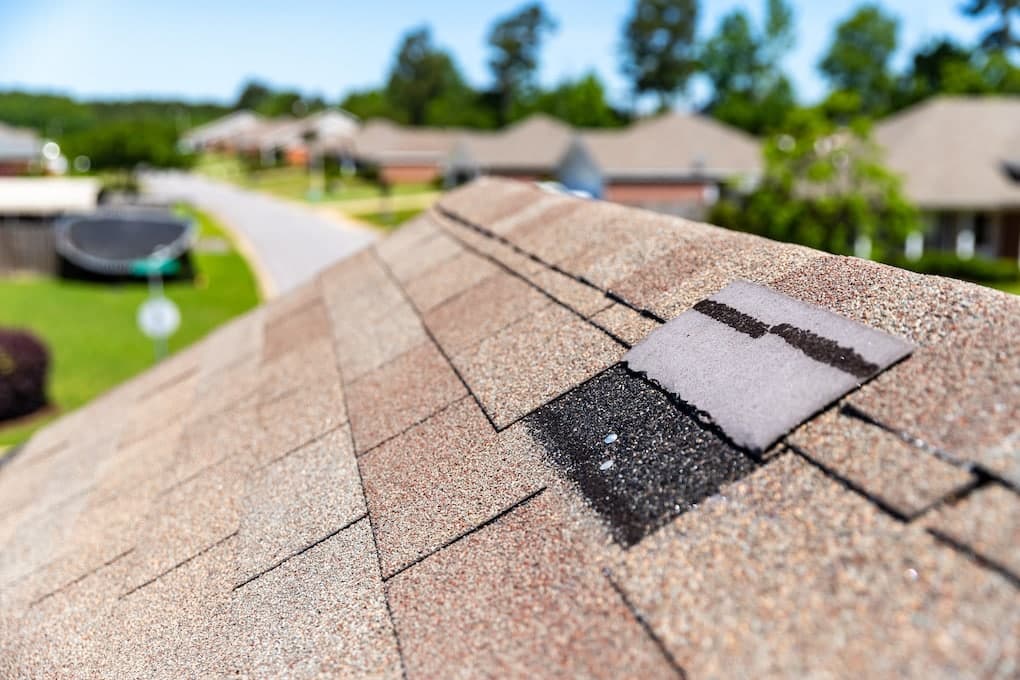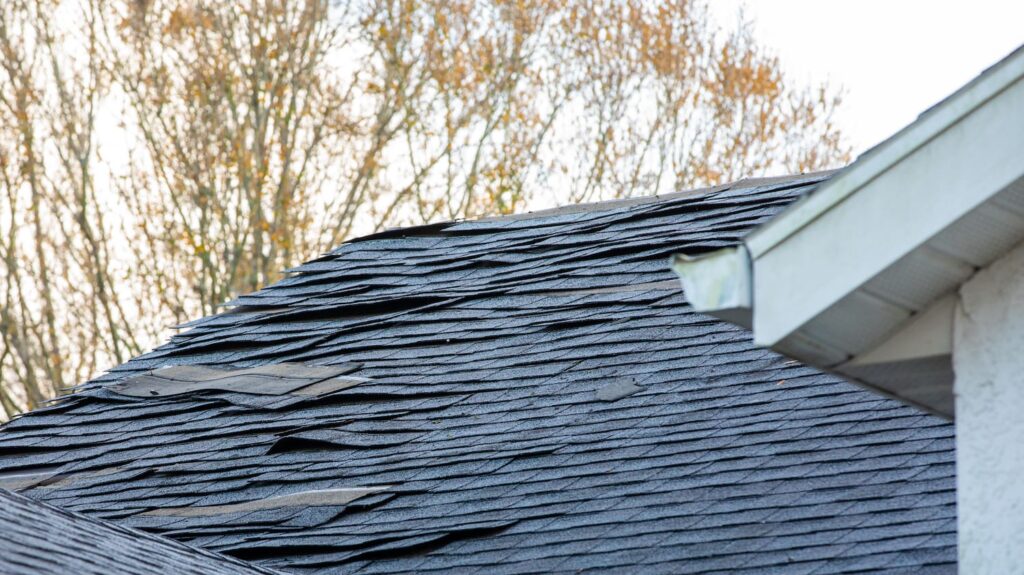Roof damage happens. And it’s always when you least expect it. When a storm hits, it can cause roof storm damage that leads to roof repairs or even a complete roof replacement if it’s severe enough.
When this happens, you’re going to want to act fast. As you wait to get an inspection or repairs, water is busy seeping in through any cracks or damage in your roof shingles. If left unattended, this will cause mold growth, water spots, or even extensive damage to your insulation.
What exactly causes damage during a storm?
- Strong winds
- Falling debris
- Hailstones
- Heavy rains
Now, just because you had any of these types of storms come through doesn’t necessarily mean your roof is damaged, but it’s essential to assess the roof anyways. As a homeowner, it’s your job to keep on top of the maintenance of your home, which includes maintaining your roof.
Without proper maintenance, your roof can weaken and become even more susceptible to storm damage and issues. Neglecting your roof can hurt you if you ever submitted an insurance claim for storm damage. If the condition of your roof is a big part of the leaks or damage that came from a storm, it can diminish the coverage you may get from insurance.
To avoid neglecting potential repairs, we’ll list out the obvious (and not so obvious) signs of roof storm damage so you can be on top of it.

How to Spot Storm Damage on Your Roof: Signs to Look For
Finding a roof leak is not the only way to know if you have roof storm damage or not. The leak may have been there for a while, and the rain is just making it more apparent. But there are much more subtle damages that can appear after a storm that has left your roof susceptible to leaks but hasn’t happened yet.
Knowing the signs is vital to protecting your home from further damage. Here are some common signs of storm damage that you should be able to spot on your own before you even get a professional inspection.
Curled, Loose, or Missing Shingles
This is one of the most apparent (and severe) roof storm damage symptoms. If you look up at your roof and find that some shingles are curled, cracked, or missing altogether, you have storm damage. While it’s possible the roof was in poor condition before the storm hit, it’s more likely that high winds and hail wreaked havoc on your poor shingles.
Visible Granule Loss
Your shingles’ granules are your roof’s first line of defense against the elements, and when those come off, your roof is weakened against rain and storms. The granules protect the underlayer of your shingle which can lead to water leaks if damaged. So those granules are very important.
Granules are tiny, so it can be hard to spot damage at first glance. But, when they slough off, they can end up in your gutters and downspouts. So if you find these little black granules in either spot, your next step should be to get your roof inspected.
Water Spots on the Ceiling
On the inside of your home, if you notice any water spots on the upper floor ceiling (which lies beneath your attic), there’s a chance you have a roof leak. Water spots can also be caused by trapped moisture in the attic, which is caused by poor insulation.
This can also be discovered during a roofing inspection, but don’t assume water spots aren’t caused by a roof leak—that can be detrimental to your home’s integrity.
If you see a new water stain on the ceiling immediately after a storm, chances are you have a big enough leak to already be soaking through the attic floor. And you need to act fast. Buckets and tarps will buy you time, but ultimately you need to contact a contractor right away to inspect and repair the leak.
Large Debris Laying on the Roof
Take note of any large debris, such as branches or large sticks laying across your roof after a storm has passed. Debris that is large enough can be blown on your roof via high winds and actually damage or even lift up the edge of your shingles, causing damage.
Note: you should always trim overhanging trees to prevent any extra-large branches from falling on your roof during a strong storm.
Dented or Discolored Shingles
Although really large hail (an inch or more) is pretty rare, wind can accelerate the impact of even small hailstones to the point of denting your shingles. But dents can be hard to see, especially from the ground. So if you notice polka-dot-looking discoloration on your shingles, that can be a good indicator of hail damage.
Clogged Gutters and Downspouts
If you live under a lot of trees, a storm can blow all kinds of twigs, leaves, and even branches into your gutters. Even large hailstones can sit in your downspouts and clog the water flow.
When your gutters or downspouts are clogged, that water has nowhere to go but into your home. Gutters and downspouts can also be incredibly susceptible to dents, cracks, and other damage—even getting torn down in high winds. So inspecting those right away can save you a ton of pain and strife dealing with water flowing improperly off your roof.
Damaged Flashing
This one will be hard to spot on your own without getting up on the roof, but if a storm damages your flashing, you could be in trouble. Flashing is installed around certain spots to make a watertight seal:
- pipe boots
- roofing vents
- chimneys
- skylights
- other roofing accessories
Flashing can get damaged when shingles nearby lift up, separating the flashing from the house, or even hailstones can dent flashing to the point of causing cracks or dents where water can get in. This damage immediately compromises your roof’s ability to ward off rainwater.
Dented Roofing Vents
Many roofing vents or pipe boots are made of metal like aluminum, making them incredibly likely for dents if a hailstorm comes through. This can affect how your roof ventilates, and if your vents or boots are damaged, your roof is at risk of trapping moisture in the attic and working inefficiently. To truly pinpoint any issues with these, you’ll need a professional inspection.

Once You Find It: How Do You Repair Storm Damage?
Now that you know you have storm damage, do you know what to do next? If not, we’ll help guide you through the next critical steps to damage repair.
But first, if a storm is really severe, make sure you and your family are safe. Powerful storms can knock out power, bring flooding or toppled trees, and other less-than-ideal scenarios. Once everyone is safe and sound, tackle any damage you may have sustained.
1) Make Temporary Fixes if Needed
If you need to fix leaks right away due to roof damage or just general roof leaks, that’s okay. You can use any materials on-hand, like buckets and tarps, until you get help from a roofing contractor.
Your roof doesn’t have to be in perfect shape for you to keep it functional. But putting off repairs can allow them to grow and get worse over time.
For instance, if you have one cracked shingle, that crack can allow water to leak through during every rainstorm, which can hurt you later on when you file an insurance claim.
2) Schedule a Roof Inspection
You will probably get your inspection scheduled during the next two steps, but you can also get the ball rolling and get an inspection right away before you file an insurance claim.
A professional roofing inspection will be far more comprehensive than you, the homeowner, taking a walk around your property and noting damages. An insurance adjuster or roofing contractor will take a long, hard look at your roof and property and, yes, uncover storm damage, but they also look at a lot of other things, such as:
- The overall condition of your roof
- If there was ever an attempt to repair damages
- Long-term water damage
- The siding and other aspects of your home
- The age of your roof (yes, they can often tell)
- Closer details that can indicate further issues
The sooner you inspect your roof for damages, the faster it can get repaired, and the sooner your home will be back in tip-top shape. Some contractors offer no-obligation inspections as well that you could get before you know your next move. Of course, contractors will offer free inspections or estimates in hopes that you will hire them, but you can always get an inspection and take your time to think about it.
3) Contact Your Insurance Company
Filing an insurance claim promptly is your best bet at getting them to pay for roof repairs or replacement. Storm damage, mainly hail and wind damage, come standard on most homeowners’ insurance policies.
Your insurance company can help get you started with an inspection, estimate, timeline, and an idea of how much the project will cost. If you are daunted by the process of filing an insurance claim or feel overwhelmed, Apple Roofing can work with you to navigate this complex process. We’ve helped hundreds of homeowners work through insurance claims and ensure they get the coverage they need.
4) Find a Reputable Contractor
The last, and most important thing you should do to repair your roof, is to find a trustworthy, reputable contractor. But finding a good roofer to get your repairs done is not always easy. After big storms, you must be wary of storm chasers or fly-by-night contractors.
These scam artists follow storms and will swarm to an area hit hard by hail or winds and knock on doors looking for someone to take them up on their too-good-to-be-true offer.
Some tell-tale signs you have a storm chaser at your door include:
- Asking for payment upfront
- “Making up” damages
- Don’t have a legitimate website
- Asking you to sign papers before looking at your roof
- Giving you a low-ball estimate
Once you close the door on them, you should head to your phone or computer and start looking up contractors near you. Read through reviews, take a look through some websites, and find testimonials of local contractors. This is vital to weed out the good vs. the bad.
Find yourself a good contractor that will:
- Offer to tarp your roof in an emergency
- Do a no-obligation inspection
- Offer a FREE, timely estimate
- Get repairs done as quickly as possible
- Work with insurance on your behalf
- Give you the roof you deserve
Finalizing Your Roof Storm Damage Repairs
We know how stressful it is when you are all-of-a-sudden facing storm damage to your roof. We hope this article helps you work through these steps with ease, alleviating some of that stress. Know that Apple Roofing is here to help you every step of the way, and our roofers are available 24/7 for roof inspections or emergency roof repairs. When disaster strikes, do not hesitate to reach out to us—our expert team will be in contact to get your roof assessed and repaired A.S.A.P. That’s the Apple way.

